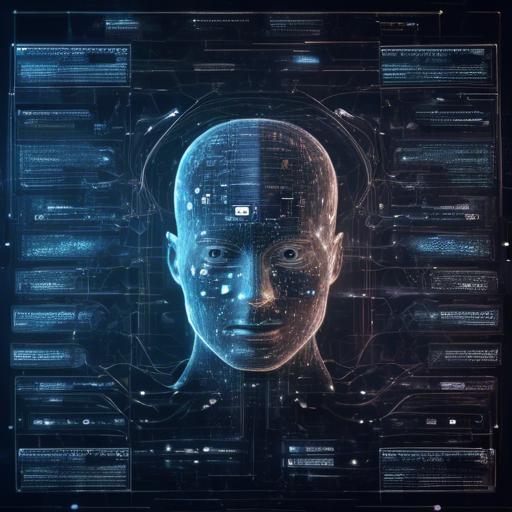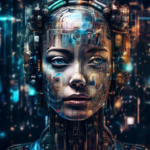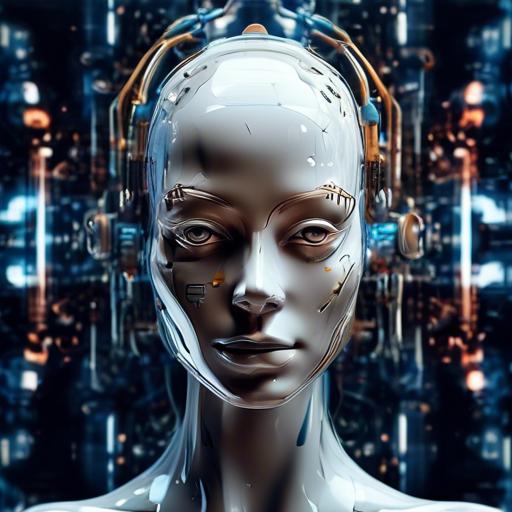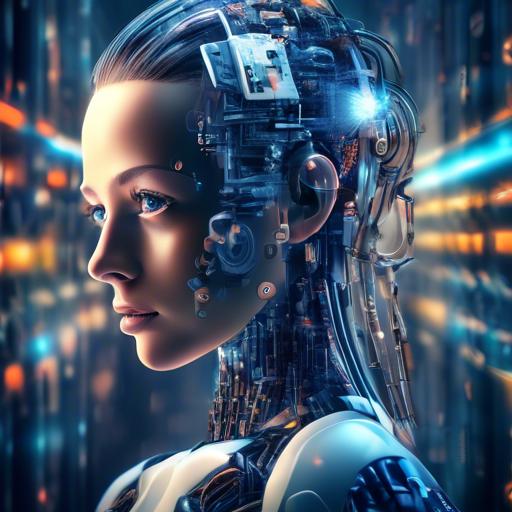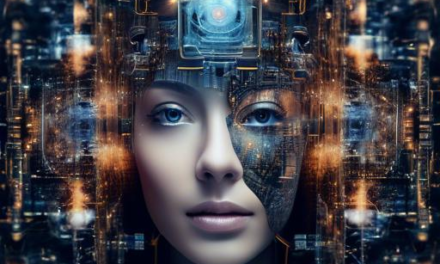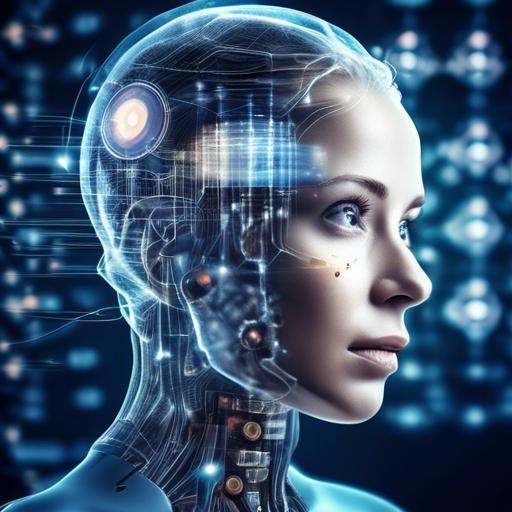Imagine walking into a vibrant art gallery where vivid masterpieces adorn the walls, each one more breathtaking than the last. Now, picture those exquisite works of art being crafted not by human hands but by intricate algorithms and groundbreaking technology. Welcome to the captivating world of AI image generation, a realm where the artistry of human imagination converges with the innovative prowess of artificial intelligence.
But before you embark on your journey through this mesmerizing field, it’s essential to understand the fundamental vocabulary that forms the foundation of this technological marvel. Whether you’re a curious newcomer or a seasoned tech enthusiast, grasping these basic terms will equip you with the knowledge to navigate and appreciate the wonders of AI-generated imagery. So, take a deep breath, relax, and let’s explore together the lexicon that brings this revolutionary art form to life.
Table of Contents
- Understanding Key Concepts in AI Image Generation
- Exploring Neural Networks and Their Role in Art Creation
- Decoding Generative Adversarial Networks (GANs) for Beginners
- The Magic of Style Transfer: How Machines Mimic Art Styles
- Navigating the World of Image Synthesis and Resolution
- Diving Into Latent Spaces: What They Are and Why They Matter
- Ethical Considerations and Best Practices in AI Art
- Tips for Getting Started with AI Image Generation Tools
- Enhancing Creativity Through Human-AI Collaboration
- Concluding Remarks
Understanding Key Concepts in AI Image Generation
Embarking on the journey of AI image generation can be both thrilling and perplexing, especially when faced with a plethora of technical terms. To shed some light on these core concepts, let’s explore a few key terminologies essential for navigating this fascinating field.
Generative Adversarial Networks (GANs): These are the powerhouses behind many recent advancements in AI-generated imagery. GANs consist of two neural networks – the generator and the discriminator. The generator creates images from random noise, while the discriminator evaluates them against real images. This adversarial “game” between the two networks sharpens their skills, resulting in increasingly realistic images over time.
Other crucial concepts include:
- Latent Space: The multi-dimensional space from which the generator samples to create new images. Understanding this can help manipulate generated outputs.
- Overfitting: When a model learns to replicate its training data too well, it fails to generalize to new data. Avoiding overfitting is essential for generating diverse and original images.
- Epoch: A single pass through the entire training dataset. More epochs usually mean better training, but with diminishing returns.
Examples of GAN Applications:
| Application | Description |
|---|---|
| Style Transfer | Merging the style of one image with the content of another. |
| Image Super-Resolution | Increasing the resolution of low-quality images. |
| Text-to-Image | Generating images from textual descriptions. |
Probabilistic models such as Variational Autoencoders (VAEs) also play a significant role. Unlike GANs, VAEs focus on learning latent spaces where each point represents a potential output with a certain probability. This allows for smoother transitions between generated images and can create more stable representations.
let’s touch on neural artistry – the creative intersection where technology meets art. Tools like DeepArt.io use AI to transform mundane photos into mesmerizing pieces of art, demonstrating the boundless potential of AI image generation. By harnessing these key concepts, you can unlock a world of creative possibilities in AI-driven artistry.
List with the most important terms for GenAi Images
| Term | Explanation |
|---|---|
| GAN (Generative Adversarial Network) | A class of machine learning frameworks where two neural networks, a generator and a discriminator, compete against each other. The generator creates images, while the discriminator tries to determine if the images are real or fake. |
| Generator | A neural network in a GAN that generates new data (images) by transforming a random noise input into a data sample that mimics the distribution of the training data. |
| Discriminator | A neural network in a GAN that evaluates the generated images from the generator and attempts to classify them as real (from the training set) or fake (generated by the generator). |
| Latent Space | An abstract multidimensional space representing compressed information of the input data. In image generation, it refers to the space from which the generator samples noise to produce images. |
| Training Data | A set of data used to train the GAN. It consists of real images that the discriminator uses to learn to distinguish between real and generated images. |
| Epoch | A single pass through the entire training dataset. Multiple epochs are often required for the model to learn effectively. |
| Loss Function | A mathematical function used to quantify the difference between the predicted output of the model and the actual output. GANs use separate loss functions for the generator and discriminator. |
| Overfitting | A scenario where the model performs well on the training data but poorly on unseen data, indicating it has learned the noise and details of the training data rather than the underlying pattern. |
| Underfitting | A scenario where the model performs poorly on both the training data and unseen data, indicating it has not learned the underlying pattern in the training data sufficiently. |
| Batch Size | The number of training samples used in one iteration of training. Adjusting the batch size can impact the model’s training efficiency and performance. |
| Noise Vector | A random input fed into the generator network to create diverse images. The noise vector is sampled from a known distribution, such as a Gaussian distribution. |
| Convolutional Neural Network (CNN) | A deep learning algorithm commonly used for processing grid-like data, such as images, by using convolutional layers to automatically and adaptively learn spatial hierarchies of features. |
| Upsampling | The process of increasing the resolution of an image by generating new pixel values. In GANs, this is often done through techniques like transposed convolutions. |
| Downsampling | The process of reducing the resolution of an image by discarding or averaging pixel values. This is commonly used in the discriminator network of GANs. |
| Activation Function | A function applied to the output of a neural network layer to introduce non-linearity, enabling the network to learn more complex patterns. Common activation functions include ReLU, sigmoid, and tanh. |
| ReLU (Rectified Linear Unit) | An activation function that outputs the input if it is positive; otherwise, it outputs zero. It is widely used due to its simplicity and effectiveness in deep neural networks. |
| Epoch | One complete cycle through the entire training dataset. During each epoch, the model’s weights are updated as it learns from the data. |
| Iteration | A single update of the model’s parameters using a batch of training data. Multiple iterations make up an epoch. |
| Learning Rate | A hyperparameter that controls the step size of the model’s parameter updates during training. It affects the speed and stability of the learning process. |
| Hyperparameters | Settings that define the structure and behavior of the model, such as learning rate, batch size, and number of layers. They are not learned from the data but are set before training. |
| Bias | A parameter in neural networks that allows the model to fit the training data better by shifting the activation function. It helps the model learn the data’s underlying pattern. |
| Weights | Parameters in a neural network that are adjusted during training to minimize the loss function. They determine the importance of input features in predicting the output. |
| Backpropagation | A training algorithm for neural networks where the error is calculated and propagated backward through the network to update the weights, minimizing the loss function. |
| Gradient Descent | An optimization algorithm used to minimize the loss function by iteratively adjusting the model’s parameters in the direction of the steepest descent of the gradient. |
| Adam Optimizer | An optimization algorithm that combines the benefits of two other extensions of stochastic gradient descent: adaptive gradient algorithm (AdaGrad) and root mean square propagation (RMSProp). It is widely used for training deep learning models. |
| Feature Map | An intermediate representation of the input data in a neural network, showing the presence of various features detected by the network’s filters. |
| Dropout | A regularization technique where randomly selected neurons are ignored during training to prevent overfitting. It helps improve the generalization of the model. |
| Normalization | The process of scaling input data to a standard range or distribution, improving the training process’s efficiency and stability. Common methods include min-max scaling and Z-score normalization. |
| Data Augmentation | Techniques used to artificially increase the size and diversity of the training dataset by applying transformations like rotation, flipping, and scaling to existing data. |
| Transfer Learning | A technique where a pre-trained model on a large dataset is fine-tuned on a smaller, task-specific dataset. It leverages the learned features from the pre-trained model to improve performance and reduce training time. |
| Style Transfer | A technique in image generation where the style of one image is applied to the content of another, creating a new image that combines the content of the first image with the style of the second. |
| Pix2Pix | A type of GAN used for image-to-image translation tasks, where the goal is to convert an input image to a corresponding output image, such as turning sketches into realistic photos. |
| CycleGAN | A type of GAN designed for unpaired image-to-image translation tasks, where the model learns to translate images from one domain to another without requiring paired examples. |
| Inception Score | A metric used to evaluate the quality of generated images by measuring how realistic and diverse they are, based on a pre-trained Inception model. |
| Fréchet Inception Distance (FID) | A metric that compares the distribution of generated images with real images, measuring the similarity of the two distributions to assess the quality of the generated images. |
| Conditional GAN (cGAN) | A type of GAN where both the generator and discriminator are conditioned on additional information, such as class labels or data from other modalities, to control the image generation process. |
| Image Synthesis | The process of generating new images using machine learning models, often by sampling from a learned distribution of image data. |
| Neural Style Transfer | A technique that uses neural networks to apply the artistic style of one image to the content of another, creating a stylized version of the original content image. |
| Super-Resolution | A process of increasing the resolution of an image using deep learning techniques, producing a high-resolution version of a low-resolution input image. |
| PixelRNN | A type of neural network model designed for generating images pixel by pixel, modeling the conditional distribution of each pixel given the previous pixels. |
| Variational Autoencoder (VAE) | A generative model that learns to encode input data into a latent space and then decode it back into an output image, allowing for the generation of new images by sampling from the latent space. |
| Autoencoder | A type of neural network used for unsupervised learning that learns to encode input data into a compressed representation and then decode it back into the original data, often used for dimensionality reduction. |
| Perceptual Loss | A loss function that measures the difference between high-level features of images extracted by a pre-trained network, often used to improve the perceptual quality of generated images. |
| Image-to-Image Translation | A task in image generation where an input image is transformed into an output image with different characteristics, such as changing day to night or transforming sketches into photographs. |
| Progressive GAN | A type of GAN that grows both the generator and discriminator progressively, starting from low resolution and adding layers to increase the resolution, leading to higher quality images. |
| Generative Model | A type of model that learns to generate new data samples from the same distribution as the training data, often used in image, text, and audio generation tasks. |
Exploring Neural Networks and Their Role in Art Creation
- Input Layer: Receives initial data.
- Hidden Layers: Process the data through various non-linear transformations.
- Output Layer: Produces the final result, often an image.
Understanding the concept of **training** is crucial. During the training phase, the neural network learns by adjusting the weights of connections based on the errors of its predictions. This process, known as **backpropagation**, helps in minimizing the error and refining the network for better accuracy. The training dataset, full of diverse images, acts as the muse, guiding the neural network toward artistic finesse.
| Term | Description |
|---|---|
| Neuron | Basic unit of a neural network |
| Layer | Collections of neurons operating at a specific stage |
| Training | The process of teaching the network using data |
| Backpropagation | Method for refining network accuracy |
**Generative Adversarial Networks (GANs)** have revolutionized AI-driven art. They consist of two sub-networks: the generator and the discriminator. The generator creates images, while the discriminator evaluates them, distinguishing between real and synthetic images. This adversarial game pushes the generator to produce increasingly realistic images, fostering a continuous improvement cycle.
Incorporating neural networks into art creation opens a Pandora’s box of possibilities. Artists and technologists collaborate, blending traditional craftsmanship with cutting-edge technology to explore the boundaries of creativity. Whether it’s generating surreal landscapes or hyper-realistic portraits, neural networks serve as powerful brushes painting the canvas of the future.
Decoding Generative Adversarial Networks (GANs) for Beginners
Generative Adversarial Networks, often referred to as GANs, are a revolutionary concept in the world of AI image generation. At their core, they consist of two neural networks, the Generator and the Discriminator, working in a sort of game-theoretic tug-of-war. This interplay allows GANs to create highly realistic images from scratch, a process that can seem like magic to beginners.
The Generator is responsible for creating images. It starts with a random noise and gradually learns to produce images that can fool the Discriminator. On the other hand, the Discriminator’s role is to distinguish between real images and the ones generated by the Generator. This adversarial process continues until the Generator becomes so good at creating images that the Discriminator can no longer tell the difference.
- Latent Space: Think of this as the creative space where the Generator looks for inspiration. It starts with a random point in this space and transforms it into an image.
- Epoch: One complete cycle through the training dataset. In each epoch, both the Generator and Discriminator get a little better at their respective tasks.
- Loss Function: A measure of how well the Generator and Discriminator are performing. The goal is to minimize the Generator’s loss while maximizing the Discriminator’s accuracy.
Commonly Used Terms in GANs
| Term | Description |
|---|---|
| Overfitting | When the model performs well on training data but poorly on new data. |
| Mode Collapse | When the Generator produces very similar images, lacking variety. |
| Convergence | The point at which the Generator’s images are indistinguishable from real images. |
While this all might seem complex, the key idea is simple and elegant: by making two models compete, one gets better at creating images, and the other gets better at critiquing them. This competition drives innovation and results in images that can be astoundingly realistic. Whether you’re an artist looking to explore new creative horizons or a tech enthusiast eager to dive into the depths of AI, understanding the basics of GANs is your first step into a fascinating world.
The Magic of Style Transfer: How Machines Mimic Art Styles
- Content Image: The original image that you want to transform.
- Style Image: The artwork whose style you wish to apply to the content image.
- Output Image: The result of merging the style image’s characteristics with the content image.
To better understand how different artists’ styles can be emulated, let’s take a look at some popular styles and what they translate to in the realm of AI-driven art. Here’s a quick rundown:
| Artist | Style Characteristics |
|---|---|
| Vincent Van Gogh | Swirling brush strokes, striking color contrasts |
| Claude Monet | Soft, light-dappled textures, pastel hues |
| Pablo Picasso | Geometric shapes, fragmented forms |
The magic happens when combining scientific principles with artistic finesse, ushering a new era where **creativity** and **technology** coalesce. Style transfer can be seen as an ambitious bridge that strengthens our connection to art, providing endless possibilities for **photographers**, **designers**, and **artists** to reimagine their work.
Navigating the World of Image Synthesis and Resolution
Generative Adversarial Networks are at the heart of many AI-driven image generation processes. They consist of two neural networks, the generator and the discriminator, which work in tandem. The generator creates images, while the discriminator evaluates their authenticity, leading to increasingly realistic outputs over time.
2. Image Resolution and Quality
Resolution plays a crucial role in the quality of synthesized images. It determines the level of detail and clarity. Below is a simple table highlighting common image resolutions:
| Resolution | Pixels | Usage |
|---|---|---|
| Low | 640×480 | Thumbnails |
| Medium | 1280×720 | Web Content |
| High | 1920×1080 | |
| Ultra | 3840×2160 | Professional Use |
3. Deep Learning and Neural Networks
These are the backbone of AI image synthesis. Deep learning involves training models with vast amounts of data, enabling them to learn complex patterns. Neural networks, structured in layers, mimic the human brain’s functioning, allowing the creation and recognition of highly intricate image details.
- Input Layer: Receives raw data.
- Hidden Layers: Process and transform data.
- Output Layer: Delivers the final image.
Embracing these concepts helps demystify the sophisticated technologies driving AI image generation. Whether you’re a beginner or an enthusiast, understanding the basics paves the way for meaningful exploration and creative application in this intriguing field.
Diving Into Latent Spaces: What They Are and Why They Matter
Latent spaces might sound like something out of a sci-fi novel, but they’re crucial in the realm of AI image generation. Essentially, they are multi-dimensional spaces that transform complex data into simpler, compact representations. Think of latent spaces as the hidden layers where AI finds patterns and learns nuances from a flood of information.
Here’s the magic: When an AI model, like a generative adversarial network (GAN), delves into these spaces, it discovers abstract features such as shapes, textures, and even styles. This process allows the model to morph a jumble of random noise into a coherent, artwork-like image. It’s like a sculptor chiseling away at a block of marble to reveal an intricate statue hidden within.
Latent spaces are not just about squeezing data into a smaller form; they enable AI to generate new possibilities with creative flair. From art and design to medical imaging, the impact is profound. To understand this better, let’s break down some core concepts:
- Dimensionality Reduction: The process of reducing the number of random variables under consideration, making the data easier to visualize and process.
- Manifold Learning: A type of learning aimed at discovering the low-dimensional structures embedded in high-dimensional data.
- Interpolation: The method of estimating unknown data points within the range of a discrete set of known data points, allowing smooth transitions and transformations.
Imagine you have a dataset of various dog images. In a high-dimensional space, each image represents a point. Latent spaces simplify this data into fewer dimensions, revealing underlying patterns like breed, size, and color. This compresses the rich information into a format that’s much easier to handle and manipulate.
| Concept | Description |
|---|---|
| Latent Vector | A point in the latent space that encodes specific features of an image. |
| Generative Model | An AI model that creates new data samples resembling the original dataset. |
| Decoder | A component that maps a point in the latent space back to the original data space. |
Ethical Considerations and Best Practices in AI Art
- **Transparency:** Artists using AI tools should be open about their use, providing insight into how the AI contributed to the artwork.
- **Consent:** Ensure that any data or imagery fed into AI systems is sourced ethically, with proper permissions.
- **Bias Mitigation:** Strive to use diverse datasets to train AI models to avoid perpetuating stereotypes or biases.
A key component of ethical AI art is the proper **attribution of credit**. This involves recognizing the contributions of not only the artist but also the developers behind the AI tools and the sources of the datasets. Here’s a helpful breakdown:
| Contributor | Role |
|---|---|
| Artist | Concept Creator |
| AI Developers | Tool Innovators |
| Data Providers | Source Contributors |
**Cultural sensitivity** is another crucial area. Engaging with broad cultural contexts respectfully ensures that AI-generated artworks do not inadvertently offend or misrepresent any group. AI artists should be mindful of the cultural and historical significance embedded within the data they use.
Lastly, fostering **sustainability** in AI art practice is vital. The computational power required for generating high-quality AI art can be resource-intensive. Artists and engineers should consider energy-efficient algorithms and sustainable practices to lessen the environmental impact.
Applying these principles helps cultivate an ethical landscape in AI art, ensuring that innovation and creativity flourish responsibly and inclusively.
Tips for Getting Started with AI Image Generation Tools
- Know Your Tools: Different AI image generation tools come with varying capabilities and interfaces. Take the time to explore and understand the features of platforms like DALL-E, MidJourney, or DeepArt.io.
- Experiment with Prompts: The key to generating captivating images often lies in the prompts you use. Experiment with different phrasings and keywords. Remember, specific and context-rich prompts tend to yield better results.
- Manage Expectations: While AI tools are powerful, they are not flawless. Keep in mind that initial outputs may not always meet your expectations, and it might take several iterations to achieve the desired results.
Choose the Right Settings: Many tools offer various settings to control aspects like resolution, style, and complexity. Adjust these settings based on your project requirements. Higher resolution settings might produce more detailed images but could also take longer to process.
| Tool | Special Feature |
|---|---|
| DALL-E | High-quality artistic renderings |
| MidJourney | Real-time adjustments |
| DeepArt.io | Art style transfer |
Community Engagement: Engaging with online communities and forums can offer invaluable insights and support. Platforms like Reddit, Discord, and specialized Facebook groups can be treasure troves of tips, examples, and troubleshooting advice.
- Saving and Documenting: Keep a log of your prompts, settings, and results. This practice will help you refine your technique and understand what works best for your creative visions.
- Stay Updated: AI image generation is a rapidly evolving field. Subscribe to newsletters, follow industry leaders on social media, and read up on the latest research to stay ahead of the curve.
Enhancing Creativity Through Human-AI Collaboration
When humans collaborate with AI in image generation, the creative possibilities are endless. By understanding the key terminology, we can better harness the power of this collaboration. Here are some essential terms to help navigate the fascinating world of AI-powered creativity:
- Generative Adversarial Network (GAN): A type of neural network where two models, a generator and a discriminator, work against each other to create realistic images.
- Style Transfer: A technique that applies the artistic style of one image to the content of another, blending inseparably the style of the ‘artist’ with the subject of the ’canvas’.
- Image Super-Resolution: Enhances the resolution of images, creating sharper and more detailed visuals from lower-quality inputs.
- DALL·E: An AI model by OpenAI capable of generating images from textual descriptions, merging the nuances of language with visual artistry.
Each of these concepts plays a crucial role in how AI assists in the creative process. For instance, understanding GANs opens the door to a world where AI can autonomously generate realistic human faces, landscapes, or even novel abstract art pieces, pushing the boundaries of traditional artistry.
Moreover, tools like Style Transfer inspire artists to explore new mediums without extensive technical knowledge. Imagine taking the vibrant brush strokes of Van Gogh and seamlessly applying them to a modern photograph—this technique makes that possible, encouraging artistic experimentation.
| Term | Description | Application |
|---|---|---|
| GAN | Generates realistic images via competition between two models. | Creating lifelike human faces |
| Style Transfer | Blend artistic styles with existing content images. | Transforming photos into artworks |
| Image Super-Resolution | Enhances image quality and detail. | Improving resolution of old photos |
By mastering these terms, artists, designers, and creators can fully leverage AI tools to push creative boundaries and bring unique visions to life. It’s a harmonious dance between human intuition and machine precision, creating art that couldn’t exist without their joint effort.
Concluding Remarks
In this article, we have delved into the fascinating world of AI image generation and deciphered some of the basic terminology for you. We hope that this has shed some light on the complex processes at play behind the scenes of artificial intelligence. As you continue to explore this cutting-edge technology, remember that understanding the terminology is just the first step towards mastering it. Keep learning, experimenting, and pushing the boundaries of what is possible in AI image generation. The future is bright, and with your creativity and curiosity, the possibilities are endless. Keep dreaming, keep creating, and keep pushing the limits. The world of AI image generation awaits your next masterpiece. Happy creating!

